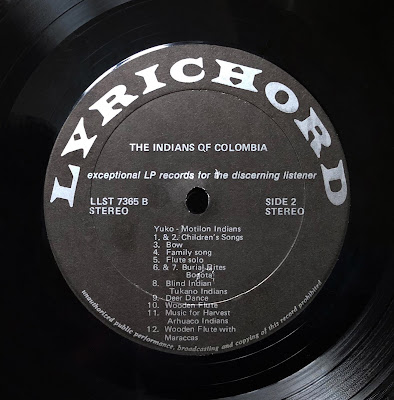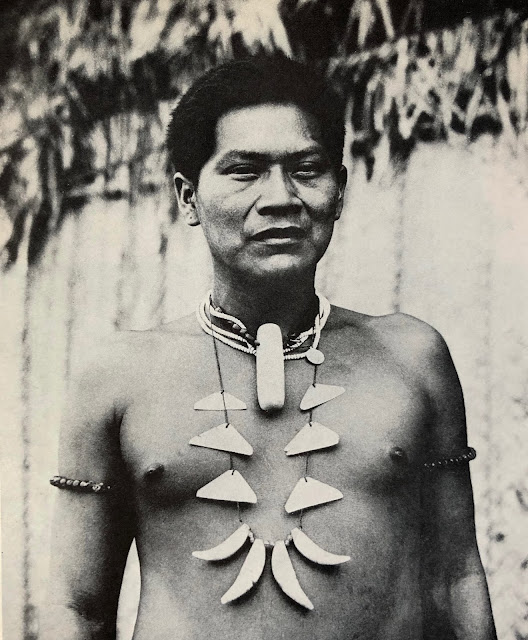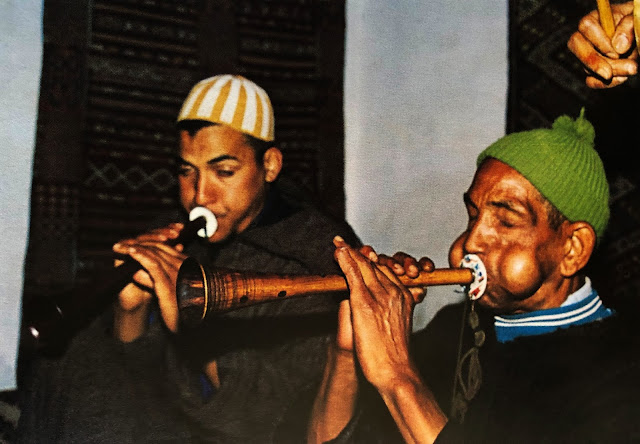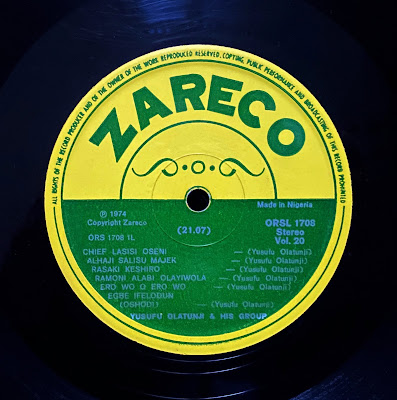COLOMBIA – COLOMBIE
The Indians of Colombia – Lyrichord - LLST 7365, recorded by Lars Persson, 1963-1972 (LP)

We now present this fascinating anthology of Colombian indigenous music from the Cuna, Cuiva, Yuko-Motilon, Arhuaco, and Tucano peoples. The musics featured here include abstract and otherworldly flutes, pan pipes, whistling, voices, bows, rattles, drums and maracas.
Nous présentons maintenant cette fascinante anthologie de musique indigène colombienne d’antan. Ces musiques abstraites et éthérées des peuples Cuna, Cuiva, Yuko-Motilon, Arhuaco et Tukano comprennent diverses flûtes, des sifflements, des voix, un instrument à archet, des hochets, des tambours et des maracas.
Cuna People
Cuna medicine men, called kantules, safeguard the transmission of both their spiritual traditions and knowledge of medicine. These Cuna musics presented here was connected with religious festivals, initiation rites, and shamanic healing. Recorded in Caiman Nuevo, on the Gulf of Uraba, in 1966.
A1 – Flutes to accompany a kantule medicine man while he blows tobacco smoke on a patient.
A2 – A kantule medicine man plays an eagle-bone flute.
A3-A6 – Initiation rite, featuring bamboo flutes and maracas.
Cuiva People
The Cuiva people were one of the last surviving nomadic cultures in South America. The Cuiva lived in forests bordering the rivers that snake through the broad savannas of eastern Columbia. Recorded in 1970.
A7 – Dialog song accompanied by maracas.
A8 – Dialog song between a man and a woman.
A9 – Deer-horn flute.
A10 – Dopa Celebration. At the beginning of this track we hear the pounding of a plant used to make the hallucinogenic vision-inducing snuff used exclusively during semi-annual dance celebrations.
Yuko-Motilon People
In the 1960s, the Yuko-Motilon people lived in small villages in Colombia’s northeast mountains. They used a wide variety of flutes, including bone flutes, pan flutes, and bamboo flutes played in pairs, and the large atunsa axe flute. Music played an important role in their burial ceremony (Yowari). Recorded in 1963 and 1968.
B1 & B2– Childrens' songs. B2 was recorded during a thunderstorm.
B3 – Softly played bow.
B4 – A family singing inside their hut in the evening.
B5 – Long Atunsa bamboo flute played during the corn harvest.
B6 & B7 – Funeral Rites with singing, flutes and stomping.
Bogota
B8 – A blind indigenous musician plays drum with his foot, and maracas and pan pipes with his left and right hands in the midst of Bogota’s heavy traffic. The music is rooted in 16th-century Muisca culture. Recorded in 1966.
Tucano People
The Tucano (or Tukano) people (see photograph below) are one of many indigenous cultures living in the jungles of the southeastern Vaupes-Caqueta regions. Once a year, the entire community participates in the harvest celebration, with painted bodies, facial bark and wooden masks, and striking feathered ornaments. Recorded in 1966 (B9-B10) and 1972 (B11).
B9 – Deer dance. Deer-skull flute and a turtle shell rubbed on its waxed edges.
B10 – Wooden flute
B11 – Music at harvest festival. Nocturnal dance. Two 160-cm- (5.3-ft) long bamboo flutes are blown in pairs at the entrance of the maloka (communal house) with the sound of the Vaupés River heard in the background.
Arhuaco People
The Arhuaco live in the Sierra Nevada de Santa Marta, a high mountain range in northernmost Colombia. Recorded in 1968.
B12 – Wooden flutes with maracas.
Our other South American Indigenous music posts:
Wayapi music from French Guiana – Selaf-Orstom Ceto, 1977-1979 here
Indians and Animals from Brazil and Paraguay – Unidisc, mid-1970s here
Please help me purchase important traditional records to pursue my global
curation project and share the best finds with you on this blog:















